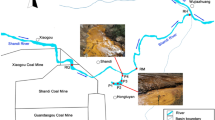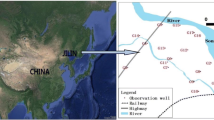Abstract
The effects of acid mine drainage (AMD) in a stream and groundwater near an abandoned copper mine were characterized by physicochemical properties, bacterial community structure using denaturing gel gradient electrophoresis (DGGE), and microbial activity/diversity using Ecoplate technique. Based on DGGE fingerprints, the eubacterial community structures grouped into the stream water (GRS1, GRS2 and GRS3) and groundwater samples (GW1 and GW2), apparently based on differences in water temperature and the concentrations of dissolved oxygen, nitrate and sulfate. The most highly AMD-contaminated sample (GRS1) had additional α-Proteobacteria whereas the groundwater samples included additional β-Proteobacteria, suggesting the development of populations resistant to AMD toxicity under aerobic and anaerobic conditions, respectively. Community level physiological activities on the 31 Ecoplate substrates suggested that the activities decreased with increasing concentrations of sulfate and heavy metals derived from AMD. The Shannon index showed that microbial diversity was greatest in GRS2, and lowest in GRS1, and was probably related to the level of AMD.





Similar content being viewed by others
References
Baker BJ, Banfield JF (2003) Microbial communities in acid mine drainage. FEMS Microbiol Ecol 44:139–152
Banks D, Younger PL, Ameson R, Iverson ER, Banks SB (1997) Mine-water chemistry: the good, the bad and the ugly. Environ Geol 32:157–174
Ben-David EA, Holden PJ, Stone DJ M, Harch BD, Foster LJ (2004) The use of phospholipid fatty acid analysis to measure impact of acid rock drainage on microbial communities in sediments. Microb Ecol 48:300–315
Bruneel O, Duran R, Casiot D, Elbaz-Poulichet F, Personné JC (2006) Diversity of microorganisms in Fe-As-rich acid mine drainage waters of Carnoulès, France. Appl Environ Microbiol 72:551–556
Edwards KJ, Bond PL, Gihring TM, Banfield JF (2000) An archaeal iron-oxidizing extreme acidophile important in acid mine drainage. Science 279:1796–1799
El Khalil H, El Hamiani O, Bitton G, Ouazzani N, Boularbah A (2008) Heavy metal contamination from mining sites in South Morocco: monitoring metal content and toxicity of soil runoff and groundwater. Environ Monit Assess 136:147–160
Fang J, Barcelona MJ (1998) Biogeochemical evidence for microbial community change in a jet fuel hydrocarbons-contaminated aquifer. Org Geochem 29:899–907
Garland JL, Mills AL (1991) Classification and characterization of heterotrophic microbial communities on the basis of patterns of community-level, sole-carbon-source utilization. Appl Environ Microbiol 57:2351–2359
Hallberg KB, Johnson DB (2001) Biodiversity of acidophilic microorganisms. Adv Appl Microbiol 49:37–84
Harries J (1997) Acid mine drainage in Australia. Office of the Supervising Scientist Report No. 125. Australia: Darwin
He Z, Xiao S, Xie X, Zhong H, Hu Y, Li Q, Gao F, Li G, Liu J, Qiu G (2007) Molecular diversity of microbial community in acid mine drainages of Yunfu sulfide mine. Exremophiles 11:305–314
Herlihy AT, Mills AL, Hornberger GM, Bruckner AE (1987) Sulfate reduction in freshwater sediments receiving acid mine drainage. Appl Environ Microbiol 49:179–186
Kelly M (1988) Mining and the freshwater environment. Elsevier, Cambridge, pp 43–63
Kelly DP, Wood AP (2000) Reclassification of some species of Thiobacillus to the newly designated genera Acidithiobacillus gen. nov., Halothiobacillus gen. nov. and Thermithiobacillus. Int J Syst Evol Microbiol 50:511–516
Kim J, Kang SH, Min KA, Cho KS, Lee IS (2006) Rhizosphere microbial activity during phytoremediation of diesel-contaminated soil. J Environ Sci Health A Tox Hazard Subst Environ Eng 41:2503–2516
Léveillé SA, Leduc LG, Ferroni GD, Telang AJ, Voordouw G (2001) Monitoring of bacteria in acid mine environments by reverse sample genome probing. Can J Microbiol 47:431–442
MCIE (Ministry of Commence, Industry and Energy) (2006) Mine Pollution Prevention Plan (2007–2011). Release copy of MCIE, Korea. http//www.mocie.go.kr. Accessed 3 March 2008
Miguel CS, Dulinskia M, Tate RLIII (2007) Direct comparison of individual substrate utilization from a CLPP study: a new analysis for metabolic diversity data. Soil Biol Biochem 39:1870–1877
Morales TA, Dopson M, Athar R, Herbert RB Jr (2005) Analysis of bacterial diversity in acidic pond water and compost after treatment of artificial acid mine drainage for metal removal. Biotechnol Bioeng 90:543–551
Nicomrat D, Dick WA, Tuovinen OH (2006) Assessment of the microbial community in a constructed wetland that receives acid coal mine drainage. Microb Ecol 51:83–89
Okabayashi A, Wakai S, Kanao T, Sugio T, Kamimura K (2005) Diversity of 16S ribosomal DNA-defined bacterial population in acid rock drainage from Japanese pyrite mine. J Biosci Bioeng 100:644–652
Salomons W (1995) Environmental impact of metals derived from mining activities: processes, predictions, prevention. J Geochem Explor 52:5–23
Tan GL, Shu WS, Hallberg KB, Li F, Lan CY, Huang LN (2007) Cultivation-dependent and cultivation-independent characterization of the microbial community in acid mine drainage associated with acidic Pb/Zn mine tailings at Lechang, Guangdong, China. FEMS Microbiol Ecol 59:118–126
Weber KP, Gehder M, Legge RL (2008) Assessment of changes in the microbial community of constructed wetland mesocosms in response to acid mine drainage exposure. Water Res 42:180–188
Zhang HB, Yang MX, Shi W, Zheng Y, Sha T, Zhao ZW (2007) Bacterial diversity in mine tailings compared by cultivation and cultivation-independent methods and their resistance to lead and cadmium. Microb Ecol 54:705–712
Acknowledgments
This research was supported by a grant (project: Application of groundwater ecology to characterization of groundwater systems and contaminant behavior) from the Korea Research Council of Public Science & Technology. S. Y. Koo and J. Y. Kim were financially supported by the Korea Science and Engineering Foundation (KOSEF) through the Advanced Environmental Biotechnology Research Center at Pohang University of Science and Technology (R11-2003-006-06001-0). E. H. Lee was financially supported by the KOSEF NRL Program grant funded by the Korea government (MEST) (R0A-2008-000-20044-0).
Author information
Authors and Affiliations
Corresponding author
Rights and permissions
About this article
Cite this article
Kim, J., Koo, SY., Kim, JY. et al. Influence of acid mine drainage on microbial communities in stream and groundwater samples at Guryong Mine, South Korea. Environ Geol 58, 1567–1574 (2009). https://doi.org/10.1007/s00254-008-1663-8
Received:
Accepted:
Published:
Issue Date:
DOI: https://doi.org/10.1007/s00254-008-1663-8




